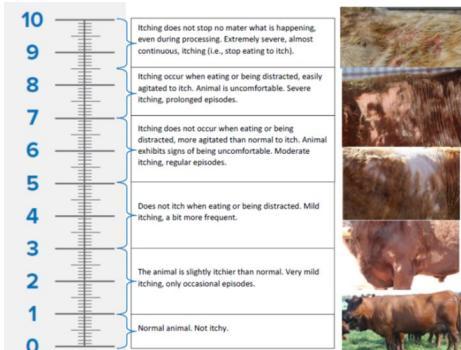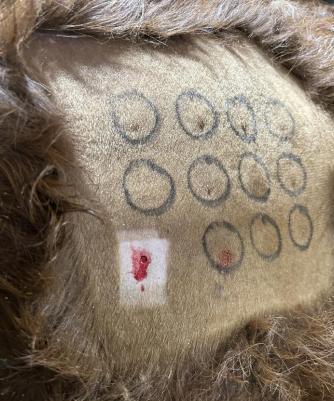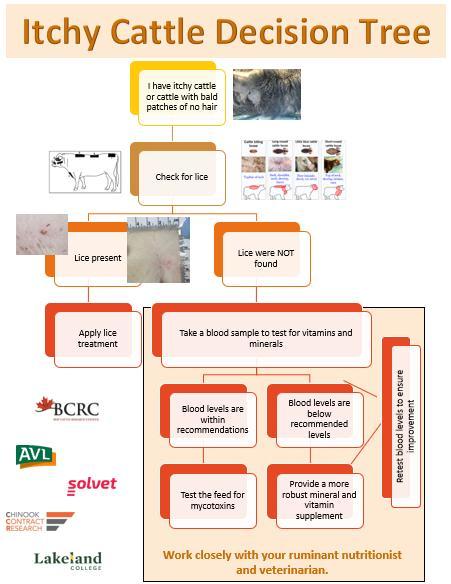
Scratching the surface: Investigating the prevalence, nature and potential causes of itchy cattle
Research team
Dr. Brenda Ralston, Dr. Merle Olson, Dr. Denis Nagel and their research teams
Collaborators
• Alberta Veterinary Laboratories Ltd., Calgary, Alta.
• Chinook Contract Research, Airdrie, Alta.
• Lakeland College
Funders
• Beef Cattle Research Council
• Alberta Beef Producers
Summary
In cattle, pruritus (itching) is a clinical sign of skin disease and is often associated with hair loss, swelling, crusting, and scaling. Severe scratching on fencing and feed equipment are the most common signs a producer observes when cattle have winter hair loss.
Itching and hair loss may reduce the value when animals are sold for breeding. The causes of itching can include:
1. ectoparasites (lice, mites)
2. bacterial and fungal pathogens (e.g. ringworm)

3. environmental allergies (plant, fungal, parasitic)
4. environmental irritants (dry air, freezing of skin, chemicals)
5. nutritional deficiencies
6. nutritional toxins (mycotoxins).
Western Canadian producers have often thought that itching is associated with infestations with lice. Still, investigations of individual herds by pharmaceutical companies providing topical insecticides such as ivermectin have failed to show lice infestations in treated

animals. Through this study, we attempted to identify the cause of itchy cattle within seven herds in Western Canada.
Background
In Canada, producers and veterinarians commonly report "itchy cattle" with hair loss in winter and the cause of itching is usually unknown and often blamed on the presence of lice despite being unable to find any, or if found, present in low numbers. Animals do not usually respond to treatment with topical insecticides (ivermectin or permethrins).
Itchy cattle are stressed and often damage corrals and fencing. Breeding bulls and cows with severe hair loss have potentially reduced commercial value. Suspected causes of itching include environmental factors (i.e., barley hull allergies, frostbite), nutrition (i.e., vitamin A or zinc deficiency), mycotoxin exposure (i.e., ergot, citrinin, T2 toxins), or parasitic sources (i.e., biting/sucking lice or mites). A comprehensive study had never been conducted to address the cause(s) of winter itching and hair loss in Western Canada herds.
Methodology
Producers with itchy cattle, referred to the research team by their local veterinarian, were interviewed by one of the team members to collect initial information on the herds’ previous parasite treatment and current hair loss issues. If herds met the criteria of at least 30 per cwent of animals experiencing moderate to severe itching and the producers had adequate management records, the herd was enrolled in the study.
A site report - herd enrollment form was completed detailing nutritional programs, water quality, bedding conditions, feeding systems, and overall description of hair loss circumstances. Once information was collected, arrangements were made for a farm visit to collect samples from a target of 10 itching and five non-itching cattle within the herd.

The severity of itching was scored using the Pruritus Visual Analog Scale (PVAS) developed by the research team. Zero indicated no itching, and 10 indicated itching that continues no matter what is happening to the animal.

Tests performed on the animals included:
1. Examination for lice
2. blood tests for mycotoxins and vitamin/mineral levels
3. allergen testing
4. skin biopsies for mites and mange
5. skin hydration readings
6. liver biopsies for mineral and vitamin levels.
Feed, water and bedding samples were also collected for analysis.
Results
One commonly blamed cause of itching is ectoparasites, including mites and lice.
Chorioptic mange caused by the Chorioptes bovis mite is one of the most common mites found in Alberta cattle. These mites do not burrow deeply into the animals’ skin as compared to the Sarcoptes scabiei mite that causes sarcoptic manage and is a federally reportable disease in Canada. Skin scrapings were taken from 15 cows (targeting 10 itchy/ five non-itchy) within each of the seven herds and examined for the presence of mites. No mites were found in any of the samples collected.
Lice infestations have been associated with animal blood loss, reduced birth weights in calves, excessive scratching, lower weight gains and damages to hides caused by louse induced itching. Louse numbers were considered an infestation if they were more than 10 lice per 6.5 cm2.
There are two types of lice common in Western Canada, the chewing louse (Bovicola bovis) and the sucking louse (Linognathus vituli), which is the most common on beef cattle.
The chewing louse is the most damaging louse found on cattle and feeds on skin surface debris, does not feed on blood. Its chewing mouth parts abrade the outer skin layers and may cause an immune response resulting in irritation and hair loss.
Sucking lice feed on blood and rarely causes clinical signs. Lice were only observed on 21 of the 101 cattle examined and one species (Linognathus vituli, Long-Nosed Sucking louse) was identified in very low numbers (<10 lice per 6.5 cm2) which did not constitute an infestation.
There was 73 per cent (47/64 hd) of the itchy cattle with no visible louse infestation and 89% (33/37 hd) of the non-itchy cattle with no lice found. There was also no significant association between the presence of lice and pruritic cattle. These findings indicate that lice infestations were not the cause of hair loss and itching in the cattle examined in this study.

Minerals and vitamins play a very important role in the health of cattle including immunity, growth, physical condition and fertility, with deficiencies resulting in clinical and subclinical signs. Cattle do not possess “nutritional wisdom” or the ability to consciously balance their own diets to maintain adequate mineral and vitamin levels. This is particularly evident when cattle are offered free-choice minerals and vitamins, resulting in high variability of intake across the herd. Mineral levels in forages and grains are primarily dependent on the mineral availability from the soil, whether that is from the soil composition or additions of minerals made to the crops by producers. Factors that can influence the crop’s ability to take up minerals include soil acidity, moisture or drainage conditions, temperatures and seasonal effects, organic matter, microbial activity and the presence of other elements that may inhibit uptake from the soil by the plant.
Minerals and vitamin supplements, if consumed at prescribed levels, should have provided adequate levels, however all the farms providing free choice minerals and vitamins had serum level copper deficient cows and liver biopsies of itchy cows were significantly lower in copper than non-itchy cows. Analysis was performed on rations to assess the potential for high molybdenum levels tying up copper absorption in the animals. Molybdenum levels were considered low and all Cu:Mo ratios were greater than two which is considered significant for creating a Cu deficiency in cattle.
Why it matters
Automatically treating itchy cattle losing their hair for ectoparasites can be costly and unnecessary. Doing a more thorough examination of the affected cattle would be more effective and prudent. A decision tree was created to investigate the issue.


